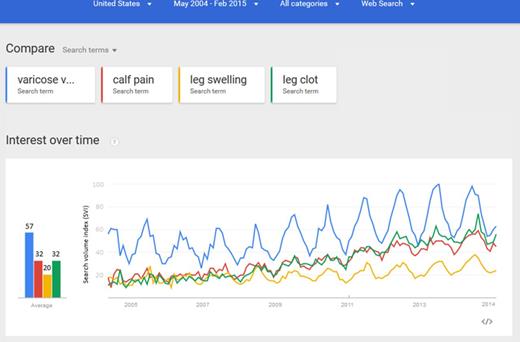Abstract
Background:
Analysis of internet search traffic has provided a new proxy measure into the trends and patterns of patients' diseases and their information-seeking behaviors. In recent years, Google Trends has become a data resource of interest given its status as the largest internet search provider in the world with publicly-viewable, passively-collected, and expansive data on any searchable term or combination of terms. For instance, search terms related to influenza (e.g. fever) predicted influenza spread faster than standard surveillance as shown by Ginsberg et al in Nature 2009. The true outpatient burden and incidence of venous thromboembolism (VTE) has long been debated. Extant VTE data are limited to cases that present to medical attention, thus missing any cases that do not come to an emergency department or clinic. We hypothesized that Google Trends analysis offers potential insight into the general populations' blood clot burden and awareness. This study aimed to explore general trends of VTE-related terms and seasonal variation in searches.
Methods:
Google Trends was utilized to obtain relative search engine traffic values (defined as search volume indices, SVIs) for terms related to DVT in the United States from summer 2004 - winter 2015. Terms related to LEG SWELLING, CALF PAIN, VARICOSE VEINS, and LEG CLOT were used and combined with Boolean operators to combine similar terms. A separate search occurred for BLOOD CLOT and related terms to investigate awareness of VTEs. Analysis was performed in R (V3.1.1) in accordance with previously published Google Trends investigations.
Results:
The average relative volume of searches was highest for VARICOSE VEINS and lowest for LEG SWELLING by approximately 3.2 fold. A seasonal pattern was seen with summer months (May-Aug) having higher SVIs than winter months (Nov-Feb) for all terms in the 11 year study period except for BLOOD CLOT. Using a Wilcoxon signed rank test, mean SVI difference comparing summer to winter for LEG SWELLING showed W = 66 (p = 0.004), for CALF PAIN W = 66 (p = 0.003), for VARICOSE VEINS W = 67 (p = 0.004), and for LEG CLOT W = 65 (p = 0.005). For BLOOD CLOT, a gradual increase in SVIs was seen and characterized by a Mann-Kendall test as having a significant positive trend, S = 898, p = 0.024.
Conclusions:
Search terms related to VTE in the United States show a strong seasonal pattern with greater search activity in summer months compared to winters months. These data suggest a higher incidence and burden of VTE in the summer. This challenges previous notions of a weakly higher incidence of VTE in winter months, calculated as a relative risk of 1.143 by Dentali et al in 2011. The gradual increase in relative search traffic for BLOOD CLOT terms reflects a likely rising awareness and/or true rise in the incidence of VTEs in the United States from 2004-2015. Further studies should investigate whether internet search traffic correlates directly with total yearly DVT incidence rates.
Keywords:
Population, venous thromboembolism, incidence
Khorana:Leo Pharma: Consultancy, Honoraria, Membership on an entity's Board of Directors or advisory committees; Janssen: Consultancy, Honoraria, Membership on an entity's Board of Directors or advisory committees; Daiichi Sankyo: Consultancy, Honoraria; sanofi: Consultancy, Honoraria; Pfizer: Consultancy, Honoraria; Boehringer-Ingelheim: Consultancy, Honoraria.
Author notes
Asterisk with author names denotes non-ASH members.



This feature is available to Subscribers Only
Sign In or Create an Account Close Modal